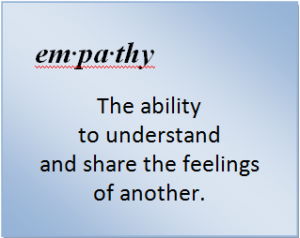Want to Build Better Customer Relationships?
 If you’d like to create a more satisfying service experience and increase customer “forgiveness” when a service encounter goes wrong, you’ll find useful tips in the latest issue of the Journal of Service Research. Jan Wieseke of Ruhr-University of Bochum, Anja Geigenmüller of the Ilmenau University of Technology, and Florian Kraus of the University of Mannheim published “On the Role of Empathy in Customer-Employee Interactions” in the August 2012 issue, offering employee- and customer-related strategies for success:
If you’d like to create a more satisfying service experience and increase customer “forgiveness” when a service encounter goes wrong, you’ll find useful tips in the latest issue of the Journal of Service Research. Jan Wieseke of Ruhr-University of Bochum, Anja Geigenmüller of the Ilmenau University of Technology, and Florian Kraus of the University of Mannheim published “On the Role of Empathy in Customer-Employee Interactions” in the August 2012 issue, offering employee- and customer-related strategies for success:
Experiencing pleasant and successful service encounters determines customers’ satisfaction with a service. Where mutual attentiveness, courtesy, and understanding are apparent in customer-employee interactions, satisfying service outcomes can be achieved. By contrast, flawed interactions may result in dissatisfaction, anger and frustration and hence impair a service provider’s attempts to deliver its services in an effective and efficient manner. This gives rise to the question how service providers can stimulate smooth and beneficial customer-employee interactions.
Service research and management support the notion that empathy is a crucial factor for successful service interactions. Yet, research on dimensions and impacts of empathy in customer-employee interactions it still in its infancy. This study conceptualizes and empirically demonstrates the impact of employee and customer empathy on customer satisfaction and loyalty. Employee empathy refers to the caring and individualized attention service employees provide their customers. Customer empathy is defined as a customer’s ability to take the employee’s perspective and to react appropriately to an employee’s thoughts and feelings.
The study reveals that customer empathy strengthens the positive effect of employee empathy on customer satisfaction, leading to more “symbiotic interactions.” The findings also indicate that empathic customers are more likely to respond to a dissatisfying encounter with “forgiveness,” in the sense that customer empathy is able to mitigate negative effects of customer dissatisfaction on customer loyalty.
Based on these results, this article suggests customer-related and employee-related strategies to create successful and valuable service encounters. More precisely, the study gives advice how to match customers and employees on the basis of a proven fit of their psychological profiles, level of empathy and preferred manner of interaction, thus implementing what is called “interaction-routing”.
Employee-related strategies involve
(1) applying candidate profiles, search mechanisms, and recruiting methods that enable firms to hire service employees capable of sensing customer expectations and fostering symbiotic customer–employee interactions;
(2) training service employees, using role plays, videotaping, or mentoring programs to enable them to “walk in the shoes of their customers” and to advance employees’ ability to sense and to react accurately to customers’ thoughts and feelings.
Customer-related strategies pertain to:
(1) the creation of customer pre-encounter profiles which allow a matching of customers and employees, enabling the customer to be directed to a frontline employee with whom he or she is most likely to experience mutual understanding and smooth interaction;
(2) the identification of suitable matches between customers and frontline employees based on customers’ ex post assessments of the interaction and communication quality in service encounters.
Read the article in the latest issue of the Journal of Service Research, and click here to receive e-alerts and get the knowledge and tools you need to cope with our increasingly service-based economy.





















































































